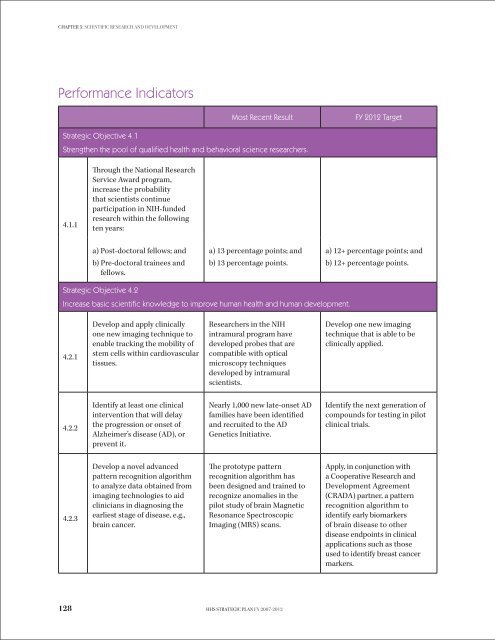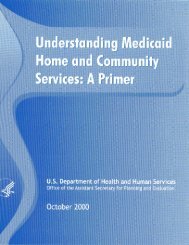STRATEGIC PLAN - ASPE - U.S. Department of Health and Human ...
STRATEGIC PLAN - ASPE - U.S. Department of Health and Human ...
STRATEGIC PLAN - ASPE - U.S. Department of Health and Human ...
You also want an ePaper? Increase the reach of your titles
YUMPU automatically turns print PDFs into web optimized ePapers that Google loves.
CHAPTER 5: Scientific Research <strong>and</strong> DevelopmentPerformance IndicatorsMost Recent ResultFY 2012 TargetStrategic Objective 4.1Strengthen the pool <strong>of</strong> qualified health <strong>and</strong> behavioral science researchers.4.1.1Through the National ResearchService Award program,increase the probabilitythat scientists continueparticipation in NIH-fundedresearch within the followingten years:a) Post-doctoral fellows; <strong>and</strong>b) Pre-doctoral trainees <strong>and</strong>fellows.Strategic Objective 4.2a) 13 percentage points; <strong>and</strong>b) 13 percentage points.a) 12+ percentage points; <strong>and</strong>b) 12+ percentage points.Increase basic scientific knowledge to improve human health <strong>and</strong> human development.4.2.1Develop <strong>and</strong> apply clinicallyone new imaging technique toenable tracking the mobility <strong>of</strong>stem cells within cardiovasculartissues.Researchers in the NIHintramural program havedeveloped probes that arecompatible with opticalmicroscopy techniquesdeveloped by intramuralscientists.Develop one new imagingtechnique that is able to beclinically applied.4.2.2Identify at least one clinicalintervention that will delaythe progression or onset <strong>of</strong>Alzheimer’s disease (AD), orprevent it.Nearly 1,000 new late-onset ADfamilies have been identified<strong>and</strong> recruited to the ADGenetics Initiative.Identify the next generation <strong>of</strong>compounds for testing in pilotclinical trials.4.2.3Develop a novel advancedpattern recognition algorithmto analyze data obtained fromimaging technologies to aidclinicians in diagnosing theearliest stage <strong>of</strong> disease, e.g.,brain cancer.The prototype patternrecognition algorithm hasbeen designed <strong>and</strong> trained torecognize anomalies in thepilot study <strong>of</strong> brain MagneticResonance SpectroscopicImaging (MRS) scans.Apply, in conjunction witha Cooperative Research <strong>and</strong>Development Agreement(CRADA) partner, a patternrecognition algorithm toidentify early biomarkers<strong>of</strong> brain disease to otherdisease endpoints in clinicalapplications such as thoseused to identify breast cancermarkers.128 HHS Strategic Plan FY 2007-2012
















